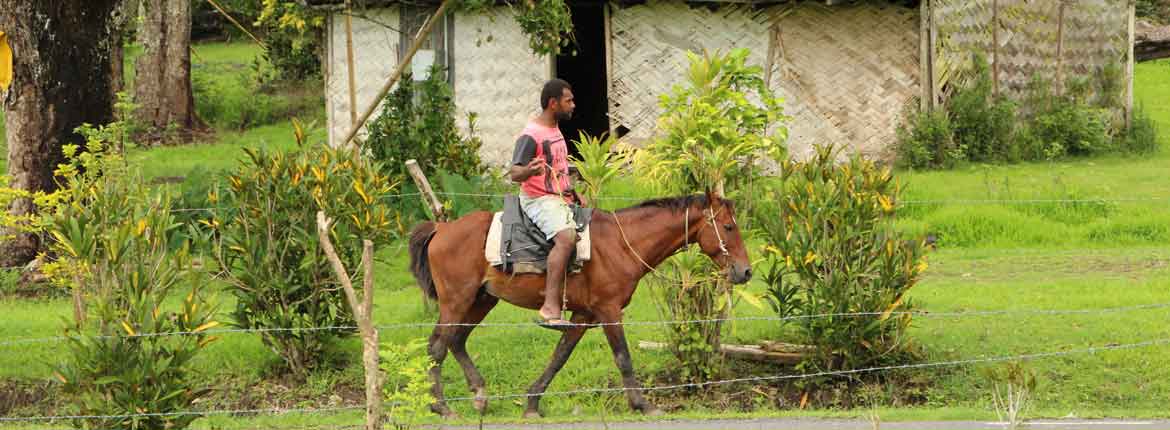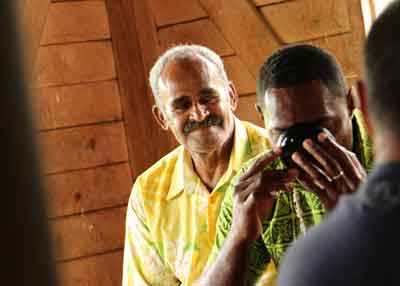
Fiji: Life in contrast
Time in Fijian villages is time well spent, says Kathryn Webster.
The wide Sigatoka River spills out onto the South-Western coast of Fiji, just beyond Sigatoka town.
It winds through a fertile valley to get there and has long been the lifeblood and the highway of that region. A narrow road follows the river but the best way to see it is by boat.
We joined a Sigatoka River Safari, climbing aboard a fast, fun jet boat which proceeded to zoom and spin and zigzag upstream; past gardens and farms, people on horseback and glimpses of villages.
Gardeners bent over at work on the riverbank raised a hand; kids ran toward the water’s edge, waving. We got to some muddy steps dug into the bank under drooping trees and climbed up to a village.
A scattering of small, low-roofed houses stood in grassy patches alongside washing lines, dogs, chickens and gardens. Locals welcomed us into one of the larger huts and we sat on woven mats amongst scattered tapa cloth; classic Pacifica cloth shaded the windows. Fijian women, dressed in bright hibiscus-print fabrics and carrying woven fans slipped simple decorations of fresh foliage and flowers around our necks.
Soon, the muddy, pulpy business in a beautiful wooden bowl became kava and the ceremony of it was delivered with claps and calls and general good cheer. Then we walked down the road past multi-coloured houses on stilts, and some sturdy concrete homes with little pathways between the road and the front doors, to a big hall where lunch was served; a feast of all sorts, beautifully, carefully presented.
Toddlers and small children – those too young for school – joined their parents and grandparents to watch, a guitar in their midst.
Music, more kava, some dancing followed. Donations were passed over – money and children’s books – and then we walked back to the river to the boat.
It was a simple and effective tour, giving us insight into life on the river and giving the villagers a chance to host. The tour company mixes it up, visiting 18 different villages along the river to share the fortune of tourism.
Back at Sigatoka, we took our rental car up the way we’d come to check out a village the tour guide had pointed out; Nakabuta, where they make pottery. It was a bit cheeky, just arriving on a whim.
Butterflies and swallows buzzed us. A couple of dogs watched us from the shade. We could hear the noise of children playing in the distance.

A smiling woman with a baby on her hip appeared and when we explained our interest, she welcomed us into the community hall and gathered other women – and soon we were being hosted with kava and a musical and dance performance, then a demonstration of their craft. Pottery vases, beads, ornaments are made quickly here, pinched, slab built, cooked low-fire on an open hearth and then covered in resin melted straight from the fire.
We were invited to see all their products, to select some to buy, which we did: tiles, decorative turtles, pigs, frogs, bowls. A sudden chaotic blast of noise heralded the arrival of galloping horses, rushing goats, running children and madly barking dogs. Some of the women leapt up, yelled out the windows, flapping their arms at the racket.
Due to leave Fiji the next day, we headed north, on the way taking one more detour into a jungle valley to ride Momi Bay Zip Lines. It was surprising, somehow, to find this enterprise in the middle of dense rainforest – but also completely logical. We climbed rickety steps higher and higher in the thick heat, more than 300 metres above sea level to wonderful coastal views and then to a huge cave that had once been a fort.
Up, along, then down we zipped on 16 lines, a gang of fit young men clipping and unclipping us, showing off their own zip-lining confidence with hilarious upside-down antics. They were having the time of their lives and seemed to love sharing it. Being in the depths of the humid, lush jungle was special; the air thick with darting butterflies and birds busy with the insect feast we humans stirred up.
From one extreme to another, our next stop was Port Denarau’s Palms Apartments which overlooked a bustle of shops, bars and cafés, with constant action from ferries and small boats coming and going. It was such a contrast to the Sigatoka River villages and of the steamy jungle, it effectively eased us into the next big contrast on our itinerary – home to everyday life in New Zealand.
Reported by Kathryn Webster for our AA Directions Summer 2019 issue
